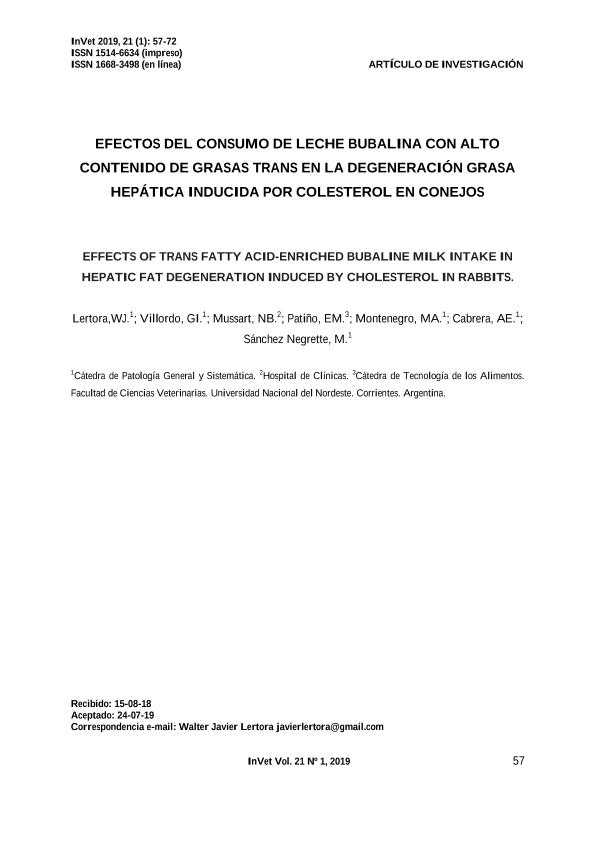Mostrar el registro sencillo del ítem
dc.contributor.author
Lertora, Walter Javier

dc.contributor.author
Villordo, Gabriela Ines

dc.contributor.author
Mussart, Norma Beatriz

dc.contributor.author
Patiño, Exequiel Maria

dc.contributor.author
Montenegro, M. A.
dc.contributor.author
Cabrera, Ailen Emilse

dc.contributor.author
Sánchez Negrette, M.
dc.date.available
2020-11-30T15:02:28Z
dc.date.issued
2019-07
dc.identifier.citation
Lertora, Walter Javier; Villordo, Gabriela Ines; Mussart, Norma Beatriz; Patiño, Exequiel Maria; Montenegro, M. A.; et al.; Efectos del consumo de leche bubalina con alto contenido de grasas trans en la degeneración grasa hepática inducida por colesterol en conejos; Universidad de Buenos Aires. Facultad de Ciencias Veterinarias; InVet; 21; 1; 7-2019; 57-72
dc.identifier.issn
514-6634
dc.identifier.uri
http://hdl.handle.net/11336/119352
dc.description.abstract
Este trabajo comparó los efectos del consumo de dos leches bubalinas, con baja y alta relación de AGt/AGS, sobre la lipemia y el desarrollo de degeneración grasa hepática inducido por colesterol en conejos. Veinte conejos neozelandeses, machos, fueron aleatoriamente separados en un grupo control (n=10) que recibió leche con baja relación AGt/AGS (5,3% de AGt y 67,12 % de AGS) obtenida de búfalas en sistema pastoril; y un grupo alto trans (n=10) que recibió leche con alta relación AGt/AGS (25,84% de AGt y 45,89% de AGS) obtenida de búfalas con suplementación lipídica en su dieta. La leche fue administrada durante 75 días y su consumo fue registrado diariamente. A partir del día 15 todos los conejos recibieron 0,93 g de colesterol/día, vía oral, para inducir degeneración grasa hepática. Se evaluó el lipidograma sérico y los niveles de ALT y AST. En hígado se midió el contenido de lípidos y, en muestras histológicas, se evaluó el área sudanofílica, la fibrosis e infiltración de macrófagos. Los conejos consumieron 9293,13 ml y 9930 ml de leche con baja y alta relación AGt/AGS, respectivamente, sin diferencia entre grupos (p 0,404). El grupo alto trans registró mayores niveles séricos de colesterol total que el control (6,08 vs. 5,58 g/l, p 0,049). Los valores de ALT fueron significativamente (p <0,0001) mayores en el grupo alto trans. El hígado registró un significativo (p 0,0437) incremento de lípidos en el grupo alto trans (10,62 % de lípidos) cuando se comparó con el control (8,68 % de lípidos). El grupo alto trans registró en el parénquima hepático mayor extensión del área sudanofílica (37,05 % vs. 26,42 %, p 0,0338), mayor frecuencia de fibrosis (8 vs. 3 hígados, p 0,0247) y mayor infiltración de macrófagos (94,20 vs. 48 macrófagos, p 0,0190) que el grupo control. En conclusión, la leche con alta relación AGt/AGS contribuyó a incrementar la colesterolemia y a incrementar el efecto hepatotóxico del colesterol, cuando se comparó con la leche con baja relación de AGt/AGS. Dichos efectos estén, posiblemente, relacionados con el contenido de AGt de esta leche.
dc.description.abstract
This work compared the effects of the two bubaline milk consumption, with low and high ratio of tFA/SFA, on lipemia and the development of hepatic fat degeneration induced by cholesterol in rabbits. Twenty New Zealand males rabbits were randomly separated into a control group (n=10) that received milk with low trans/saturated FA ratio (5.3% tFA and 67.12% SFA) obtained from grazing buffalos; and a high trans group (n=10) that received milk with high tFA/SFA ratio (25.84% tFA and 45.89% SFA) obtained from buffalos with lipid supplementation in their diet. The milk was administered for 75 days and its intake was recorded daily. From day 15, all rabbits were challenged with 0.93 g of cholesterol/day, orally, in order to induce hepatic fat degeneration. The serum lipidogram, ALT and AST were recorded. On the liver, lipid content, sudanophilic area, fibrosis and macrophage infiltration were evaluated. The rabbits voluntarily consumed 9293.13 ml and 9930 ml of milk with low and high tFA/SFA ratio, respectively, without difference between groups (p 0.404). Rabbits in high trans group registered higher serum levels of total cholesterol than the control group (6.08 vs. 5.58 g/l, p 0.049). The ALT were significantly (p <0.0001) higher in the high trans group than the control group. The liver lipids recorded a significant (p 0.0437) increase in the high trans group (10.62%) when it was compared to the control (8.68%).The high trans group recorded a greater extension of the sudanophilic area (37.05 ± 7.53% vs. 26.42 ± 12.55%, p 0.0338), a greater frequency of fibrosis (8 vs. 3 livers, p 0.0247) and more infiltration of macrophages in hepatic parenchyma (94.20 vs. 48 macrophages, p 0.0190) than the control group. In conclusion, milk with high tFA/SFA ratio contributed to increase total cholesterol levels and to increase the hepatotoxic effect of cholesterol, when was compared with milk with a low ratio of tFA/SFA. These effects are possibly related to the tFA content of this milk.
dc.format
application/pdf
dc.language.iso
spa
dc.publisher
Universidad de Buenos Aires. Facultad de Ciencias Veterinarias
dc.rights
info:eu-repo/semantics/openAccess
dc.rights.uri
https://creativecommons.org/licenses/by-nc-sa/2.5/ar/
dc.subject
RUMIANTE
dc.subject
ACIDOS GRASOS TRANS
dc.subject
CONEJO
dc.subject
HIGADO GRASO
dc.subject.classification
Ciencias Veterinarias

dc.subject.classification
Ciencias Veterinarias

dc.subject.classification
CIENCIAS AGRÍCOLAS

dc.title
Efectos del consumo de leche bubalina con alto contenido de grasas trans en la degeneración grasa hepática inducida por colesterol en conejos
dc.title
Effects of trans fatty acid-enriched bubaline milk intake in hepatic fat degeneration induced by cholesterol in rabbits
dc.type
info:eu-repo/semantics/article
dc.type
info:ar-repo/semantics/artículo
dc.type
info:eu-repo/semantics/publishedVersion
dc.date.updated
2020-11-18T17:05:59Z
dc.identifier.eissn
1668-3498
dc.journal.volume
21
dc.journal.number
1
dc.journal.pagination
57-72
dc.journal.pais
Argentina

dc.journal.ciudad
Buenos Aires
dc.description.fil
Fil: Lertora, Walter Javier. Universidad Nacional del Nordeste. Facultad de Ciencias Veterinarias; Argentina
dc.description.fil
Fil: Villordo, Gabriela Ines. Universidad Nacional del Nordeste. Facultad de Ciencias Veterinarias; Argentina
dc.description.fil
Fil: Mussart, Norma Beatriz. Universidad Nacional del Nordeste. Facultad de Ciencias Veterinarias; Argentina. Consejo Nacional de Investigaciones Científicas y Técnicas. Centro Científico Tecnológico Conicet - Nordeste; Argentina
dc.description.fil
Fil: Patiño, Exequiel Maria. Universidad Nacional del Nordeste. Facultad de Ciencias Veterinarias; Argentina
dc.description.fil
Fil: Montenegro, M. A.. Universidad Nacional del Nordeste. Facultad de Ciencias Veterinarias; Argentina
dc.description.fil
Fil: Cabrera, Ailen Emilse. Universidad Nacional del Nordeste. Facultad de Ciencias Veterinarias; Argentina
dc.description.fil
Fil: Sánchez Negrette, M.. Universidad Nacional del Nordeste. Facultad de Ciencias Veterinarias; Argentina
dc.journal.title
InVet
dc.relation.alternativeid
info:eu-repo/semantics/altIdentifier/url/http://www.fvet.uba.ar/?q=volum-21-1
dc.relation.alternativeid
info:eu-repo/semantics/altIdentifier/url/http://www.fvet.uba.ar/archivos/publicaciones/invet/vol21-1-2019/Invet-n1-2019/body/articulo-5-Vol-21-n1-2019.htm
Archivos asociados
